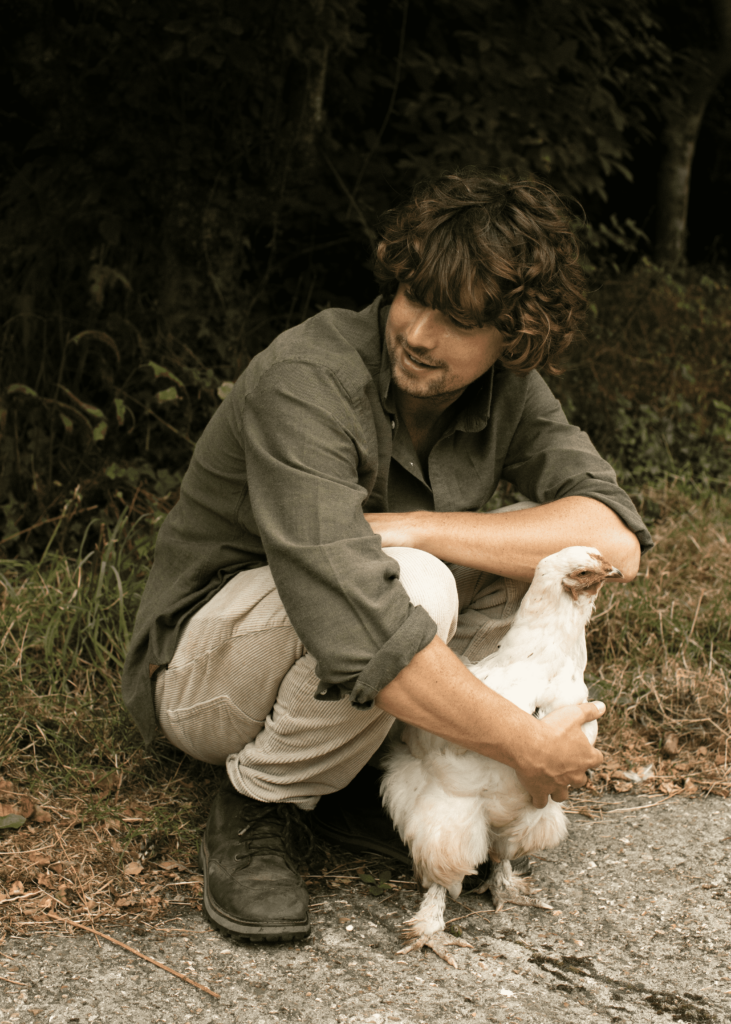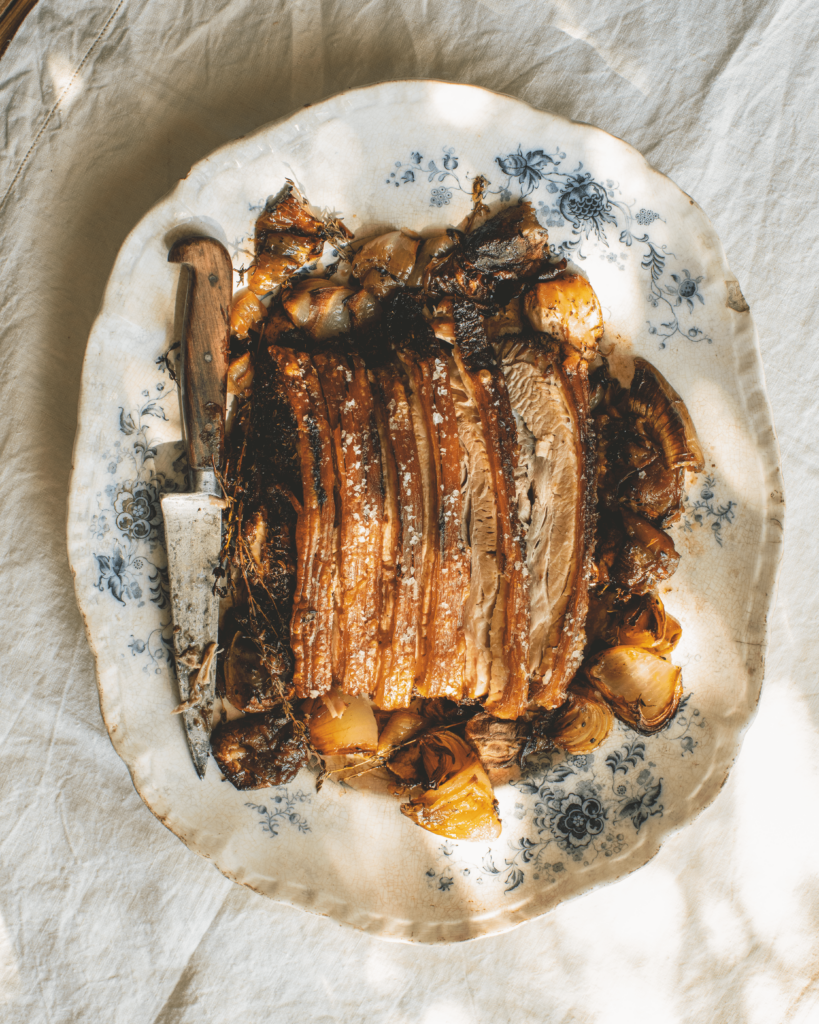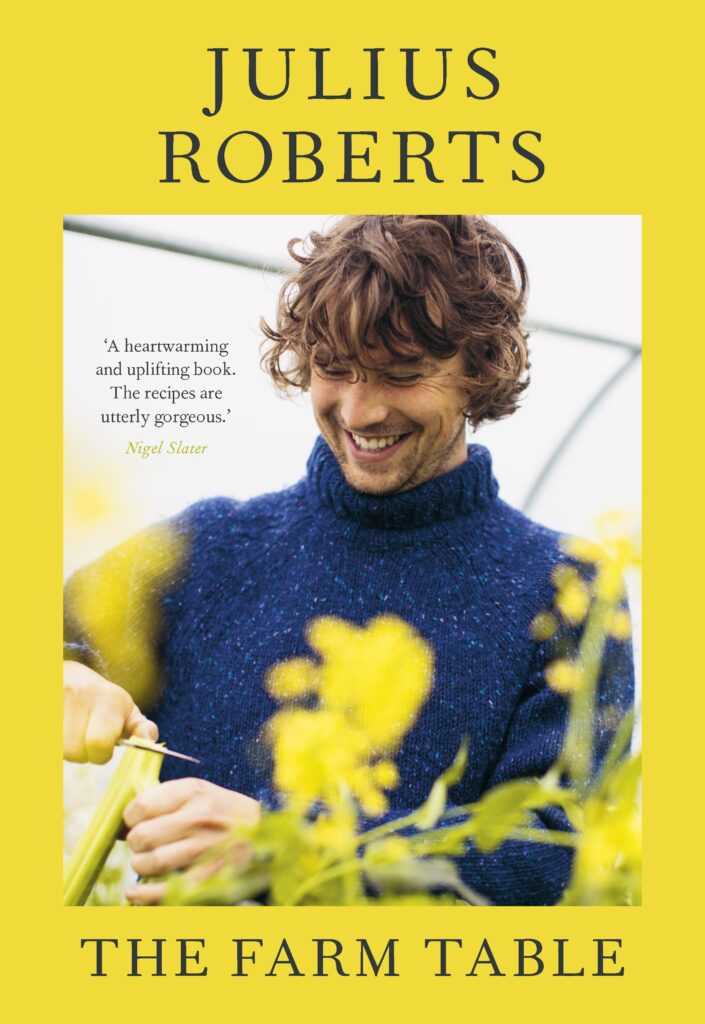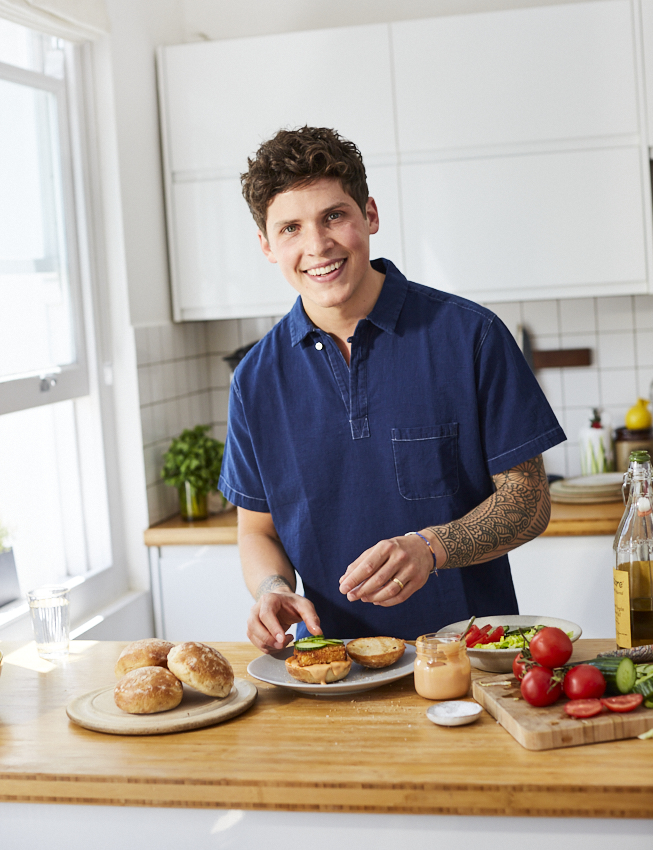
In this month’s cookbook club series with Penguin Books, we grab wellington boots and head over to the farm as we get to know more about Julius Roberts and the release of his debut cookbook, The Farm Table.
Julius Roberts is a first-generation farmer and restaurant trained chef, who lives and runs his own family smallholding in Dorset. His mission is to become self-sufficient, whilst cultivating the finest, freshest ingredients and use them within his cooking to make the very best foods.
The journey first began when Julius started working at Noble Rot, where for 8 months he learnt everything you could possibly know about cooking. It is here that Julius found a respect for quality ingredients and how they can completely transform any dishes when used. Soaking up all the knowledge and skills, Julius left the chef industry to begin a adventure into self-sufficiency, where he started a smallholding in Dorset and is now fully fledged along with the many animals he keeps.
It is through Julius’ appreciation for quality, fresh ingredients on the farm that’s allowed him to create his debut cookbook: The Farm Table. Utterly heart-warming and comforting, the recipes in the book are organised by season, cooking and eating your way to the good life with simple, fuss-free dishes.
The book begins with winter, with recipes including roast pumpkin and a hearty sausage strew. Spring introduces refreshing dishes of baked fish and herbs, and a roasted chicken, paired with lemon, fennel and potatoes. As things start to get warmer, Summer brings a colourful plate of courgette pasta and a deliciously sweet apricot sponge. Finishing with Autumn, you are greeted with warming dishes of smoked haddock and baked rarebit.
The passion about seasonality and quality ingredients runs deep throughout the cookbook, where unfussy home cooking is brought to it’s very best.

In Conversation with Julius Roberts…
Julius, HUGE congratulations on the launch of your book! What inspired you to write a cookbook set over the course of a year on the farm?
Thank you! The book is set across a year because I really wanted to emphasise the importance of seasonality. The flow of the seasons and weather entirely dictate my day to day life and inspire the food I’m eating. If it’s freezing and miserable, I cook something nourishing and comforting, in the fierce heat of summer on a day of hay making, I’ll make something light and refreshing. So in a world where we’re getting less and less connected to the natural world, I thought setting the food in the seasons and really telling that story of a year on the farm would help people understand why we eat what we do when, and encourage them to reconnect to mother nature via the food on their plate.
Out of all the seasonal chapters within the book, what season is your favourite to cook in?
While I’m very much a sun lover, I think it’s in the colder months that I do my best cooking. When the weather begins to really take its toll, you need the nourishment and warmth that a stew or pie can bring. Wet, cold and rosy cheeked after a day of sheep husbandry in the elements, is there a better feeling than coming back to the warmth of a fire with a brothy stew gently simmering on the stove and wafting through the house. The autumn and winter chapters have some staggeringly delicious cooking.

Would you say your past skills and experience as a restaurant trained chef has helped you in becoming a first-generation farmer?
They’re very different worlds, but I think my appreciation for quality ingredients and the seasons started in the restaurant and that fuelled my journey into farming. The skills and techniques I learnt during my time in restaurants also equipped me with know-how to make the most of, appreciate and take utter joy in the incredible produce we grow on the farm.
What would be your top tips for someone wanting to get into farming?
Just go for it. I have a favourite quote. You don’t have to be great to start, but you do have to start to be great. I jumped in head first at the deep end with no knowledge of farming whatsoever. Bought pigs, chickens, goats and dug a veg patch with very little understanding of what to do next. My journey has been one of many failures, learning through tough knocks and hard won lessons. And personally, I find learning by doing an utter joy, it’s always the hardest failures that teach you the most.
Tell us Julius, what does a typical day in the life look like for you?
That varies massively from season to season. In Spring, my focus is on lambing, I’m out checking the sheep late into the night with a headtorch and up early to be there for any Ewes that have trouble giving birth, any spare time I’m planting seeds in the greenhouse and getting the veg patch ready for a busy growing season ahead! Summer is much more relaxed and I get to enjoy the hard work that went on in spring, the veg patch is exploding with a bounty of produce and the fields are tall meadows rich with wildflower and alive with the sound of calling lambs and kids. We make a lot of hay which is a big job, but generally summer is a pretty peaceful season on our smallholding. Autumn is a busy time, where we make the most of the growing weather before the cold dark, days of winter begin. I spend a lot of time pickling and preserving, making jams, sauces and all sorts. We have a gazillion apple trees and take wheelbarrows of apples to the animals, who we rotate a lot through the fields at this time to maximise the last months of good grass. Then winter is a much slower period, it’s when my animals need me most and I spend a lot of time taking hay and feed to them each day, but other than that it’s a time of hibernation and very good cooking.
Your ultimate comfort-food dish?!
I really love a chicken pie. I gently poach a whole really good quality chicken, then break it down and combine it with slow cooked veg and smoked bacon. Make a creamy sauce from the broth with mustard and tarragon, then bake the whole thing in a flaky buttery crust studded with fennel seeds and salt. Utter heaven. If I never need help on job that none of use love, like cleaning out the chicken coop or mucking out a barn, this is what I make my brothers to persuade them.
Name three things in the kitchen that you simply can’t live without!
A really good sharp knife, lemons and proper salt…
Slow-Roast Crispy Pork Belly Recipe

A slow-roasted, crispy-skinned pork belly is one of the finest mouthfuls there is. Rich in flavour with a melt-in-the-mouth texture and crunchy crackling, it is a truly exceptional roast. Here are the tools to achieve beautifully crisp crackling and the juiciest meat – you need to start the recipe the night before, but it is the drying overnight in the fridge that achieves that heavenly salty crunch.
Julius loves this dish with a generous spoon of mustard mash and some lemony purple sprouting broccoli, but you can enjoy with any of your favourite sides.
Serves: 6 people
Ingredients:
- 1.5kg pork belly, skin on
- 2-3 cooking apples
- 3 large brown onions
- A few sprigs of fresh thyme
- A glass of cider or white wine
For the marinade:
- 1 1/2 tbsp sea salt
- 1 tbsp fennel seeds
- 1 tbsp dried oregano
- 1 tbsp dried thyme
Method:
- Place the pork on a wire rack in the sink. Boil a full kettle, then pour the boiling water over the pork skin – this scalds the pork and tightens the skin, which helps create amazing crackling.
- Pat dry with a tea towel, then with a craft knife, or a similarly sharp paring knife or razor, score the pork skin from edge to edge in line 1cm apart. Don’t be tempted to do diagonals, as this causes the crackling to break when carving. The aim here is to carefully score the skin down to the fat below, but do not go through to the meat, otherwise liquid will escape from the meat when cooking and ruin the crispness of the crackling. It is surprisingly tricky scoring the skin well without piercing through to the meat, so take your time. You can usually ask your butcher to do this for you,
- In a pestle and mortar, roughly bash the ingredients for the marinade together, then rub this all over the underside and sides of the pork, but leave the skin unsalted. Make sure the skin is properly dry, then place on a large plate or tray in the fridge overnight, with room for the pork to breathe. This will dry out the skin ahead of cooking the next day.
- The next day, remove the pork from the fridge and preheat your oven to 240c Fan – as high as it’ll go, essentially. Place the pork on a baking tray lined with baking parchment and pat the skin dry one last time before generously seasoning with flaky sea salt. You want to really massage it into all those nooks and crannies created by the scoring.
- Put the tray in the middle of your oven and roast for 24 minutes – 1 hour, until the skin is puffed and crackling, but keep a careful eye, rotating the tray if needs be and ensuring that it doesn’t burn. Remove from the oven and turn the heat right down to 160C. Fan.
- Peel the apples and cut into quarters, then remove the cores. Halve the onions, remove the skins and again cut into quarters or even eighths. Lift up the pork and evenly spread the apples, onions and thyme sprigs in the tray, season well and stir through the juices, then pour in the cider and place the pork back on top. Put the tray back in the oven at 160C Fan for 2 1/2 hours, by which time the pork should be supremely tender, the skin crisp and the apple and onion molten and tender.
- Turn the oven off, open the door and leave the pork in there to stay warm while it rests for 15 minutes. Spend this time getting your sides piping hot. Then remove the pork, slice and serve with lots of the lovely apple and onion.
Want to create a recipe from this book?!

You can find where to purchase Julius’ NEW cookbook here and start whipping up fuss-free, comforting dishes for your friends and family.
Make sure you have your Maldon Salt ready for these recipes! If you are running out, please feel free to browse on our Where to Buy Page to find your nearest store in which stocks our beloved Maldon Salt.
Lastly, we LOVE seeing your creations – please tag us on Instagram using the #maldonsalt so we can share your own take on Julius’ recipes!


